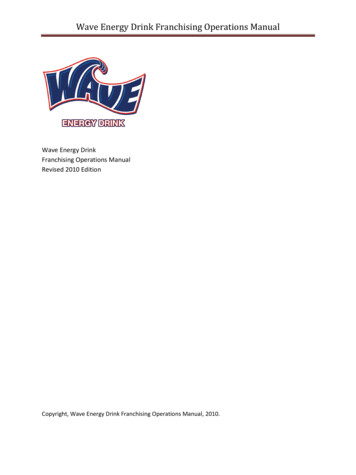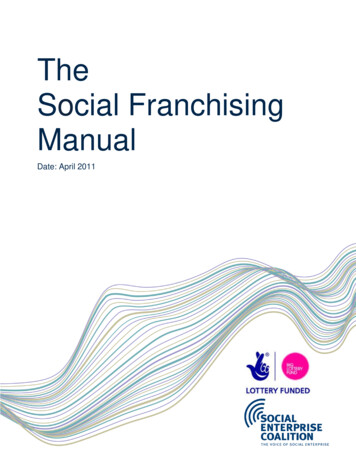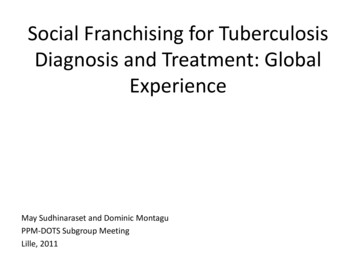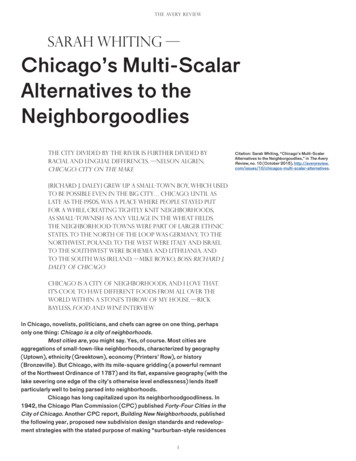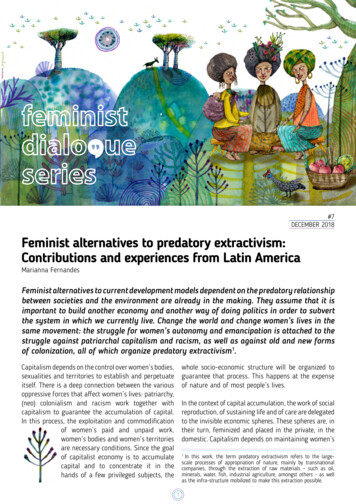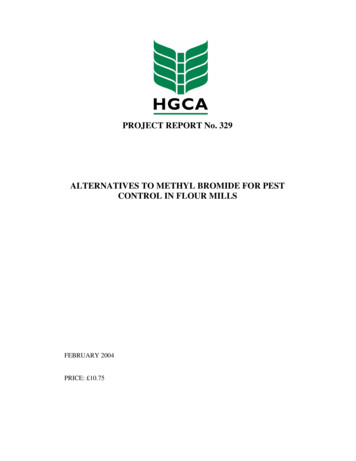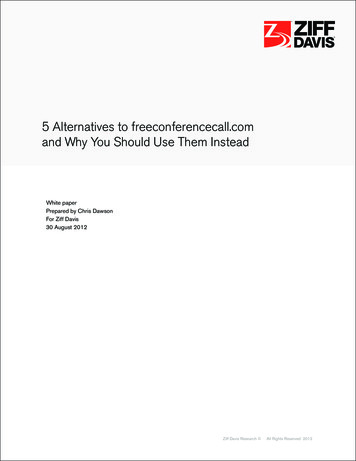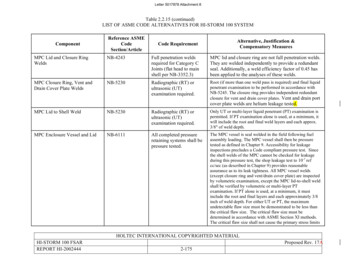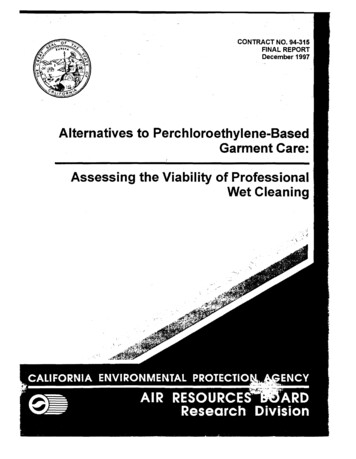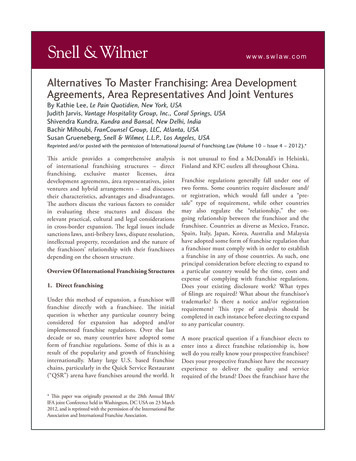
Transcription
w w w. s w l a w. c o mAlternatives To Master Franchising: Area DevelopmentAgreements, Area Representatives And Joint VenturesBy Kathie Lee, Le Pain Quotidien, New York, USAJudith Jarvis, Vantage Hospitality Group, Inc., Coral Springs, USAShivendra Kundra, Kundra and Bansal, New Delhi, IndiaBachir Mihoubi, FranCounsel Group, LLC, Atlanta, USASusan Grueneberg, Snell & Wilmer, L.L.P., Los Angeles, USAReprinted and/or posted with the permission of International Journal of Franchising Law (Volume 10 – Issue 4 – 2012).*This article provides a comprehensive analysisof international franchising structures – directfranchising, exclusive master licenses, áreadevelopment agreements, área representatives, jointventures and hybrid arrangements – and discussestheir characteristics, advantages and disadvantages.The authors discuss the various factors to considerin evaluating these stuctures and discuss therelevant practical, cultural and legal considerationsin cross-border expansion. The legal issues includesanctions laws, anti-bribery laws, dispute resolution,intellectual property, recordation and the nature ofthe franchisors’ relationship with their franchiseesdepending on the chosen structure.Overview Of International Franchising Structures1. Direct franchisingUnder this method of expansion, a franchisor willfranchise directly with a franchisee. The initialquestion is whether any particular country beingconsidered for expansion has adopted and/orimplemented franchise regulations. Over the lastdecade or so, many countries have adopted someform of franchise regulations. Some of this is as aresult of the popularity and growth of franchisinginternationally. Many large U.S. based franchisechains, particularly in the Quick Service Restaurant(“QSR”) arena have franchises around the world. It* This paper was originally presented at the 28th Annual IBA/IFA joint Conference held in Washington, DC USA on 23 March2012, and is reprinted with the permission of the International BarAssociation and International Franchise Association.is not unusual to find a McDonald’s in Helsinki,Finland and KFC outlets all throughout China.Franchise regulations generally fall under one oftwo forms. Some countries require disclosure and/or registration, which would fall under a “presale” type of requirement, while other countriesmay also regulate the “relationship,” the ongoing relationship between the franchisor and thefranchisee. Countries as diverse as Mexico, France,Spain, Italy, Japan, Korea, Australia and Malaysiahave adopted some form of franchise regulation thata franchisor must comply with in order to establisha franchise in any of those countries. As such, oneprincipal consideration before electing to expand toa particular country would be the time, costs andexpense of complying with franchise regulations.Does your existing disclosure work? What typesof filings are required? What about the franchisor’strademarks? Is there a notice and/or registrationrequirement? This type of analysis should becompleted in each instance before electing to expandto any particular country.A more practical question if a franchisor elects toenter into a direct franchise relationship is, howwell do you really know your prospective franchisee?Does your prospective franchisee have the necessaryexperience to deliver the quality and servicerequired of the brand? Does the franchisor have the
w w w. s w l a w. c o minfrastructure to deliver the training and supportneeded for the brand to prospective franchisees?Many global franchise brands, particularly inhospitality and QSRs have divisional presences thatmay include sales (development) and operationsteams in Asia, Europe, MENA nations and furtherafield. The benefit to a franchisor in having a sales/development team locally or regionally is that theteam understands the local market. Conceivably, theteam on the ground has developed or establishedrelationships with prospective franchisees and canconduct much of the vetting required to ensure thata prospect is a “qualified” prospect in a particularmarket. Further, the maintenance of a local orregional operations team is also beneficial to thefranchisor, and will provide the franchisee with thenecessary know-how, training and support needed toensure that the local franchisee is operating the unit(or units) in compliance with brand standards andin the manner required by the franchisor. The lackof a regional or local sales and operations team maybe a disadvantage to the franchisor if the franchisorseeks to franchise directly. Managing a franchiserelationship by long distance may prove to be adetriment under a direct franchising scenario sincethe ability to monitor the activities of the franchiseeis limited by time and distance.Finally, while a direct franchise approach likelyprovides the franchisor with more control over theselection of its franchisees, it may hamper growthopportunities for a franchise system since a franchiseagreement must be entered into with each and everyfranchisee directly.2. Exclusive master licenseAn exclusive master license or franchise (“ExclusiveMaster License”) is the most traditional methodused by franchisors to expand their businessesinternationally. In a typical structure, the masterfranchisee (“Master Franchisee”) is vested with theright to sub-franchise the business in a designatedgeographic area. This is a key differentiating feature ofan Exclusive Master License. The franchisor, typically,receives an initial fee for granting sub-franchisingrights to the Master Franchisee. The quantum of thisfee depends on factors such as nature of business,the duration of the Exclusive Master License, andthe number of franchises to be set up. The MasterFranchisee also shares with the franchisor thefranchise fee as well as royalty received for every unitset up by the sub-franchisee. In addition, the MasterFranchisee pays a royalty to the franchisor for unitsoperated by the Master Franchisee. For example, anExclusive Master License may provide that the MasterFranchisee would share 30 per cent of the franchisefee received and 50 per cent of the royalty for everynew unit that is set up by a sub-franchisee. There areno fixed ratios in which the fee and royalty are to beshared, this varies from agreement to agreement.Although the right to appoint a sub-franchisee isgranted to the Master Franchisee, some agreementsprovide that such a right is not absolute, and theappointment may require the concurrence of thefranchisor. As franchisors are concerned about theirbrand image, this system helps them in ensuring thatthe prospective sub-franchisees are of repute andgood standing.Typically, the Exclusive Master License provides fora development schedule, and the Master Franchiseeis expected to adhere to this schedule in terms ofdevelopment of new units. The Master Franchiseemay be obliged to establish its own units first, inorder to inspire confidence in potential franchiseesin the region by demonstrating success of thebusiness. This has the additional benefit of theMaster Franchisee becoming well-versed in thebusiness operations of the franchisor as well as intraining methods before going to the sub-franchisee.As the franchisor’s marks are used by the MasterFranchisee as well as by the sub-franchisees, thefranchisor typically establishes the standards withregard to use of the marks.
w w w. s w l a w. c o mIn this model, franchisor and Master Franchiseemay have to comply with the registration process,and depending upon jurisdiction, disclosure mayhave to be provided.In more ways than one, the Master Franchisee acts asa franchisor vis-à-vis the sub-franchisees, providingthem with knowledge and expertise, includingoperational supervision, training, and guidance.In an international environment, one of thebig advantages of an Exclusive Master License,aside from quick expansion, is that a franchisorcan substantially cut its cost and share its riskby appointing a Master Franchisee in a foreignterritory, rather than having a joint venture or awholly-owned subsidiary.However, there are certain inherent disadvantageswith this structure. With the franchisor not being aparty to the contract between the Master Franchiseeand the sub-franchisee, the franchisor has littleor no effective control over the sub-franchisees.This may become a cause of considerable concernwith respect to issues such as brand image and useof the trademarks. On account of these pitfalls,the Exclusive Master License model is giving wayto other structures such as area development,area representation, joint ventures, and hybridarrangements.3. Area development agreementIn the Area Development Agreement (“ADA”)franchise model, a franchisor grants franchisingrights for a specific geographic location to asingle franchisee (“Area Developer”), and the AreaDeveloper opens individual units in that area over aspecified period of time.In a typical ADA, sub-franchising is not allowed, andthe Area Developer is responsible for establishingthe business units in that area, and to look afterday-to-day management of the units. However, thefranchisor may retain the right, by direct ownershipor through franchising, to set up units in speciallocations such as airports, train and bus stations,sports facilities, and amusement parks. Anotherexclusion in terms of the ADA could be on accountof sale of products on the internet.Area Developers are typically required to pay adevelopment fee. Generally, separate franchise agreementsare entered into with regard to every unit that is developed,and a royalty is charged in terms thereof.The obvious advantage of a true Area Developmentfranchising model is that the franchisor is notsaddled with the burden of multiple franchisepartners. Also, the opportunity for quick expansionof the business is available - there being only a singlefranchisee. The need to negotiate with multiplefranchisees is eliminated.In so far as the Area Developer is concerned, givenits knowledge of local market and conditions, it willnot only be able to negotiate preferred locationsbut also negotiate prices of supplies, so as to meetchallenges from local competition. It will also havethe ability to cut costs pertaining to local advertisingand promotional programs. In its dealings with thefranchisor, the Area Developer may be in a positionto negotiate lower franchise and royalty fees.The franchisor has to watch out for the impact oflesser control over the franchised business with theArea Developer dictating growth and expansionplans for the business. In many cases, the AreaDeveloper makes substantial contributions tothe revenues of the franchisor, and the loss of aformidable Area Developer can have a big impacton the bottom line of the franchisor.When appointing an Area Developer, care shouldbe taken to ensure that it is someone who has strongcommitment to the business, with adequate financialresources and local clout to develop the business.
w w w. s w l a w. c o m4. Area representativesThe two crucial elements of the Area Representative(“Area Representative”) model are(i) solicitation and recruitment of prospectivefranchisees in a defined geographic area, and(ii) servicing franchisees, on behalf of thefranchisor, such as providing training;carryingoutperiodicinspections;carrying out local or regional advertising,and providing periodic consultation tofranchisees.In a true sense, an Area Representative Agreementmay not be classified as a franchise arrangement. Itis more in the nature of contract for services, withthe Area Representative being compensated forsoliciting franchisees and servicing them with regardto training, etc., on behalf of the franchisor. Thisis one of the reasons why an Area RepresentativeAgreement may not be subject to the stringentregistration and disclosure requirements that AreaDevelopment or Master Franchise agreement aresubject to.Unlike a Master Franchisee, an Area Representativeis not allowed to enter into any agreement withthe identified franchisee in its territory, and thefranchise agreement is executed by the franchisorand franchisee, with the Area Representative merelyfacilitating the identification and recruitmentof potential franchisees. As consideration forsoliciting and assistance with recruitment, the AreaRepresentative is paid a share of the initial franchisefee. For servicing the franchisees, the franchisor,would be expected to pay a part of the royalties toan Area Representative- depending on the quantumand type of services provided.In terms of the Area Representative Agreement,typically the right to approve or reject a prospectivefranchisee vests solely in the franchisor. In manyan agreement, the Area Representative’s right toexclusivity is subject to the franchisor’s right to setup its own units within the identified territory. TheArea Representative may not receive any revenuewhen franchisees directly approach the franchisorfor appointment.There are some crucial advantages associated withthe Area Representative model. The franchisorretains control over the franchisee, unlike the MasterFranchise model or the Area Development model.Another plus is that as compared to other franchisingstructures, Area Representative Agreements maybe terminated with more ease. A franchisor is alsorelieved of the task of maintaining a training teamand costs associated therewith. The franchisor andthe Area Developer are both in a position to harnessthe local strengths and knowledge of the AreaRepresentative.The disadvantage of the model pertains topotential vicarious liability on account of the AreaRepresentative servicing the franchisees. To thatextent, the franchisor must adequately oversee theperformance of the Area Representative vis-à-vis thefranchisees.5. Joint venturesA joint venture is not, per se, a type of franchisingarrangement, but a contractual agreement betweentwo parties to jointly promote and carry on abusiness. However, it is not uncommon to use thejoint venture model in international franchising,whereby the franchisor, eager to promote its brandand product in an international territory, enters intoa joint venture agreement with a local company, as afirst step. Subsequently, the joint venture companycan either become an area developer, or a masterfranchisee. The joint venture company typicallyenters into a brand license agreement with thefranchisor with respect to trademarks and brands tobe used.
w w w. s w l a w. c o mBeing a product of two cultures, one of thekey challenges that face a joint venture is thepartners adapting to one other’s contrasting stylesof operating. Besides, the usual problems thatconfront a joint venture such as control of theboard, deadlock, exit methodologies, and disputeresolution will also confront a franchising jointventure. On the other hand, a joint venture givesthe franchisor an opportunity to make a foray intothe international market with the help of the localpartner, whose strength lies in exploiting localknowledge and expertise.In a franchising joint venture, the franchisor canparticipate actively in the business, have a largershare in the profits of the business, coupled witha feeling of security regarding protection of itsintellectual property.Although some of the emerging markets may haverestrictions on outward remittance of royaltiespertaining to the brand, most jurisdictions donot have specific laws governing joint ventures.Therefore, the joint venture is typically subject tothe laws governing corporations.Unlike most other franchising structures, thefranchisor has to contribute capital in the jointventure company. Combined with the fact that thejoint venture company is subject to the laws of localjurisdiction, the franchisor must choose its jointventure partner carefully.6. Hybrid arrangementsFranchisors and franchisees,a particular type of franchisesometimes combine featuresfranchising structures discussedhybrid arrangement.while negotiatingarrangement, mayof the differentabove to arrive at aA hybrid arrangement, may, for example, be acombination of master franchising and an areadevelopment agreement. This combination may bestructured in different ways, such as:(i) a franchisee may first have to act as an areadeveloper, developing a certain numberof units within a specified time frameand also allowed to sub franchise, eithersimultaneously, or after it has developed itsown units, acting as a Master Franchiseewould, and/or(ii) a Master Franchisee may be allowed to enterinto an area development agreement withone of its sub-franchisee to establish units ina sub-territory.Another example of a hybrid arrangement is where anarea developer may act not only as a Master Franchiseeinsofar as the right to appoint sub-franchisees isconcerned, but also act as an Area Representativeand solicit and recruit independent franchisees,and service them on behalf of the franchisor withrespect to training, regional advertising, operationalsupervision and consultation. So, this type ofarrangement combines features of three franchisingmodels-master franchising, area development, andArea Representative.Yet another example of hybrid arrangement is wherethe franchisor enters into a joint venture with itsMaster Franchisee, with the intent to establish unitsin some pre-identified territories, while the jointventure partner is appointed Master Franchisee withrespect to other territories. This model has beenadopted in the course of international franchisingwhen a brand needs to establish credibility ina market and the initial momentum for thisdevelopment is provided by the joint venture.There are obvious advantages in combiningelements from the standard franchising models andtailoring them to the requirements of the franchisorand franchisee. A hybrid structure provides the
w w w. s w l a w. c o mflexibility that individual models may lack, whileensuring that the business is not hamstrung by therigid demands of some of the standard models.Overview Of Considerations In Cross-BorderExpansion1. CulturalName of franchiseFeasibility of using name in another countryTo avoid huge marketing mistakes, it is importantfor companies expanding internationally to ascertainthe meaning of a trademark in the targeted country.A number of brands operate under a different nameinternationally to avoid offending local consumers. Inthe Middle East, “Church’s Chicken” operates as “TexasChicken” acknowledging the fact that the overwhelmingmajority of the population is Muslim. One Americancompany was surprised that they discovered that thename of the cooking oil they were marketing in LatinAmerica translated in Spanish as “Jackass Oil.” In theApril issue of “Franchise Times,” there was mentionedthat “Pip Printing” discovered in Denmark that thename “pip” meant “crazy in the head.”Translation issuesIn most agreements, the translation is the obligationof the franchisee. However, most of the agreementsdo not provide for a professionally or linguisticallyaccurate translation. It is important to provide thattranslation of agreements must be rendered by lawyersknowledgeable in local law and with an understandingof common law concepts. Many translators have thelanguage capability but do not have the legal aptitudeto translate common law concepts.2. Consumer preferencesAny franchisor entering a new international marketshould consider whether or not to vary its systemto address local preferences. For example, somerestaurant concepts may need to modify their menuofferings to adjust to local taste. Portion sizes mayalso be affected and that can in turn require a changeto the pricing structure.In some circumstances, however, the success of thesystem in the new country or region is predicated onbeing different or on appealing to a sector of the localpopulation that has emigrated from the franchisor’shome country or has ethnic ties to it. While this maylimit the success of the concept, at least initially, tothis segment of the population, it can also providea platform from which to launch development thatca
Nov 27, 2012 · Bachir Mihoubi, FranCounsel Group, LLC, Atlanta, USA Susan Grueneberg, . In the Area Development Agreement (“ADA”) franchise model, a franchisor grants franchising rights for a specific geographic locatio
